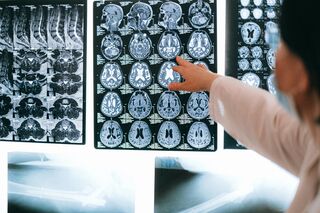Intelligence
What Animals Can Teach Us About Anorexia
Animal models of anorexia are vital for eating disorders research.
Posted November 22, 2021 Reviewed by Tyler Woods
Key points
- Anorexia research with human participants has limitations.
- Animal models of anorexia can't recreate every symptom of the disorder.
- Animal models have helped researchers explore and understand causes and consequences of, as well as possible treatments for, anorexia.
Human research poses several limitations that make studying anorexia nervosa (AN) from a neurobiological approach difficult.

First, because people clinically diagnosed with AN make up less than 1 percent of the population, finding enough human participants for a research study is challenging.9
Second, while methodologies exist (i.e., self-reports, behavioral tasks, and brain recording techniques, such as EEG and fMRI) that allow researchers to safely make inferences about the brain's role in AN, these techniques can't be used to directly look at and manipulate the brain.
In order to directly analyze the brain (e.g., quantify protein levels), researchers most likely need to work with dissected tissue. The problem here, though, is that, unlike other illnesses (such as Alzheimer's) where human brain tissue is readily available for scientific study, human tissue is difficult to obtain for AN research. This is because most people with AN tend to be young and only a small portion of the population is clinically diagnosed with it.
Considering these research limitations, as well as the low recovery rate of AN, it becomes necessary to develop animal models that allow researchers to further explore the brain’s role in AN.

Animal Models of AN
A major challenge of creating rodent models for research is making sure that they accurately mimic the symptoms of an illness in ways that are translatable to humans.
Unfortunately, animal models can't perfectly replicate every feature of a clinical disorder. This is due to biological differences between animals and humans, variations within disorders between humans, and ethical concerns.
What researchers can do is create animal models that accurately mimic key features of a specific disorder; they can then use these models to explore specific aspects of those features (i.e., what causes self-starvation) in relation to the disorder. For AN, several models have been developed, each with its own strengths and weaknesses.
Food restriction
Simply restricting a rodent’s food intake seems like an adequate research model for studying AN. However, this model lacks one important feature of AN: self-starvation. This is because, with a food restriction model, the researcher decides how much food the rodent gets every day. This makes it difficult to determine if the rodent is choosing to self-starve, or if it's simply eating what it's being given.
In contrast, individuals with AN voluntarily restrict their food intake. In other words, they have unlimited access to food, but choose not to eat it. Moreover, unlike food restriction rodent models, the amount of food people with AN consume varies across days.

Therefore, while food restriction models can help researchers explore how food restriction impacts the brain and body, they can't be used to explore relationships between the brain and motivations for self-starvation.
ANX/ANX mouse
The anx/anx mouse model of AN relies on a genetic mutation that causes early life self-starvation.4 Because it induces self-starvation, the anx/anx model is slightly more translatable to humans than the food restriction model.
One benefit of the anx/anx model is that it allows researchers to explore the genetic underpinnings contributing to self-starvation.
Nonetheless, researchers still haven't figured out exactly why this specific genetic mutation contributes to self-starvation. One possibility is that it causes neuroinflammation and neurodegeneration in the hypothalamus, a brain region that regulates eating.4
The biggest limitation of the anx/anx mouse is that, aside from excessive weight loss, the only AN symptom it models is self-starvation. Consequently, it's more a genetic model of self-starvation, rather than a model of AN. Moreover, the anx/anx mouse only lives a few weeks, making long-term studies with it impossible.
Dehydration-induced AN
Dehydration-induced AN involves replacing a rodent's water access with continuous access to a hypertonic solution (e.g., saline).5 This causes voluntary food restriction at any age, making dehydration-induced AN more robust than the anx/anx mouse.

Nonetheless, this model still has its drawbacks. Specifically, it focuses on relationships between fluid and food intake, in particular cellular dehydration. This makes it a good model for researchers interested in these relationships; however, it might not be the best choice for more general explorations of AN.
Activity-based anorexia (ABA)
ABA is considered the gold standard of AN rodent models.7 This is because it mimics three distinct AN symptoms: voluntary restricted food intake, voluntary excessive exercise, and significant weight loss. Animals put through the ABA paradigm also exhibit similar neuroendocrine, cardiac, behavioral (e.g., anxiety), and clinical features (e.g., folliculogenesis disruption) as humans with AN.3
ABA involves giving rodents (usually female adolescents) continuous access to a running wheel with two hours of continuous food access every 24 hours. This differs from food restriction models in that, in ABA, rodents can eat as much food as they want during those two hours rather than being given a specific amount of food for 24 hours. This combination of limited food access and continuous running wheel access eventually results in increased running wheel activity and voluntary decreased food intake.
What drives these behaviors in ABA?
One explanation for excessive running wheel activity in ABA is hyperactivity. Since the 1800s, hyperactivity has shown to be one of the earliest symptoms to develop in AN.6 Consequently, in addition to body dissatisfaction, hyperactivity is another known contributor to excessive exercise in AN.

Explanations for why hyperactivity manifests in ABA, and why it's accompanied with self-starvation, however, remain unclear.
According to the suppression hypothesis, this homeostatic imbalance could be the result of motor activity replacing food as the primary source of reward in ABA.1 This has been supported by brain analyses of ABA rats, which show reward processing dysfunctions.
Another explanation could be low body temperature, a common symptom in AN. The thermoregulatory hypothesis suggests that reduced body temperature in AN leads to increased physical activity for warmth.6 Nonetheless, some studies have countered this hypothesis by showing that warming ABA rodents for 12 hours doesn’t reduce ABA symptoms (e.g., hyperactivity).2 Rather, it takes continuous warming for at least 24 hours for ABA symptoms to subside.
Importantly, sex differences have been demonstrated in ABA rodents, with male and female mice showing different food intake, hyperactivity, and weight loss patterns.8 Given that AN likely manifests differently in men and women, having a model that could account for these sex differences becomes vital when developing AN treatments (e.g., pharmaceuticals).

Conclusions
Animal models have contributed to our understandings of the underlying biology of AN. This knowledge has enlightened clinicians about the possible causes (e.g., early life stress and genetics) and health consequences of AN (e.g., intestinal inflammation, gut microbiota changes, metabolic dysfunctions, and alterations in brain structure and function), as well as possible treatments for AN (e.g., deep brain stimulation and pharmaceuticals).7
Given the overwhelming ineffectiveness of treatments for AN and the disorder's high fatality rate, animal models have the potential to improve these statistics.
References
1)Spadini, S., et al. (2021). Activity-based anorexia animal model: A review of the main neurobiological findings. Journal of Eating Disorders, 9.
2)Roura, I., et al. (2020). Differential effects of heat in the phases of the light-dark cycle in the activity-based anorexia model. International Journal of Eating Disorders, 53, 1826-1835.
3)Skowron, K., et al. (2021). Is the activity-based anorexia model a reliable method of presenting peripheral clinical features of anorexia nervosa? Nutrients, 13.
4)Nilsson, I. (2019). The anx/anx mouse: A valuable resource in anorexia nervosa research. Frontiers in Neuroscience.
5)Watts, A., & Boyle, C. (2010). The functional architecture of dehydration-anorexia. Physiology & Behavior, 100, 472-477.
6)Carrera, O., et al. (2012). Hyperactivity in anorexia nervosa: Warming up not just burning off calories. PLOSOne.
7)Scharner, S., & Stengel, A. (2021). Animal models for anorexia nervosa – A systematic review. Frontiers in Human Neuroscience.
8)Achamrah, N., et al. (2017). Sex differences in response to activity-based anorexia model in C57B1/6 mice. Physiology & Behavior, 170, 1-5.
9)Hoek, H. (2006). Incidence, prevalence and mortality of anorexia nervosa and other eating disorders. Current Opinions in Psychiatry, 19, 389-394.




